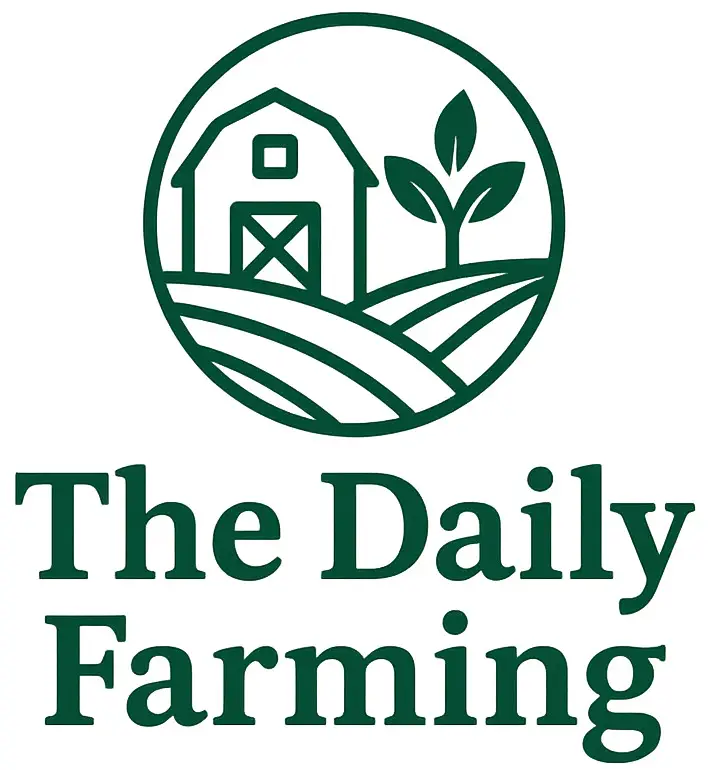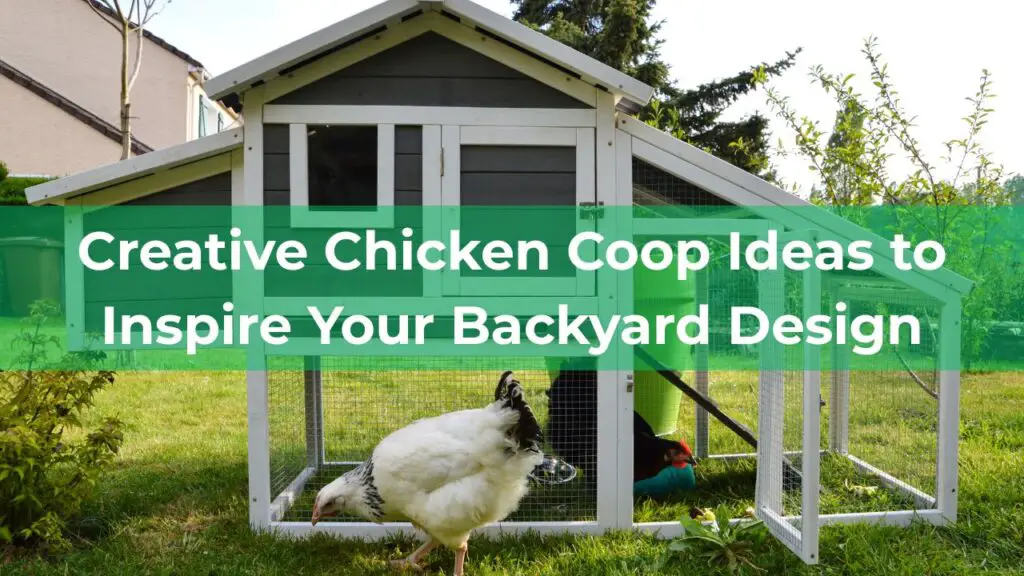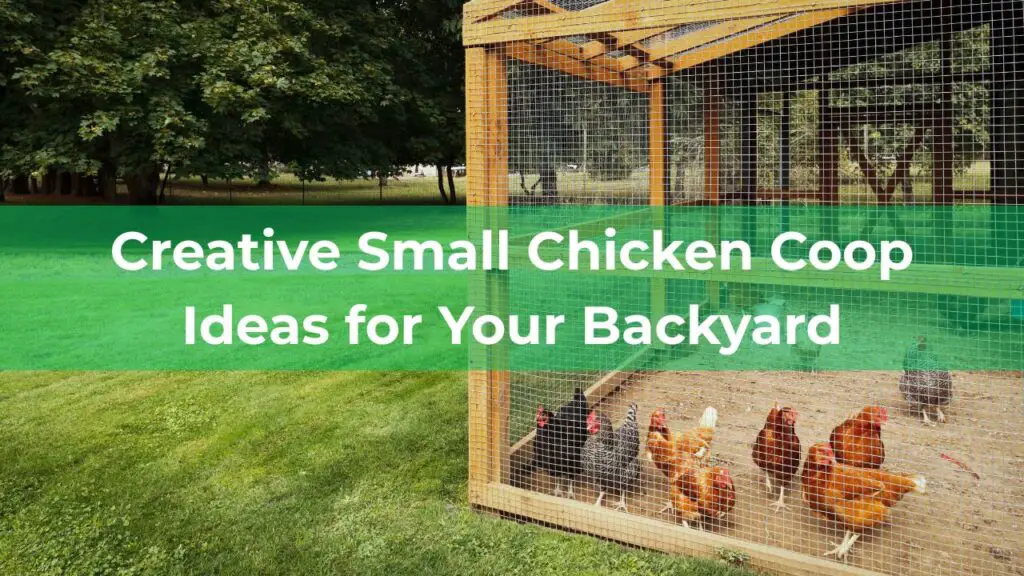Raised garden beds can revolutionize your gardening experience, offering a practical and stylish way to grow your favorite plants. Whether you’re short on space or simply want to add some flair to your outdoor area, exploring different layouts and designs can help you maximize your garden’s potential. From compact urban solutions to expansive backyard arrangements, there are plenty of creative ideas to suit any style and preference.
L-Shaped Raised Garden Bed
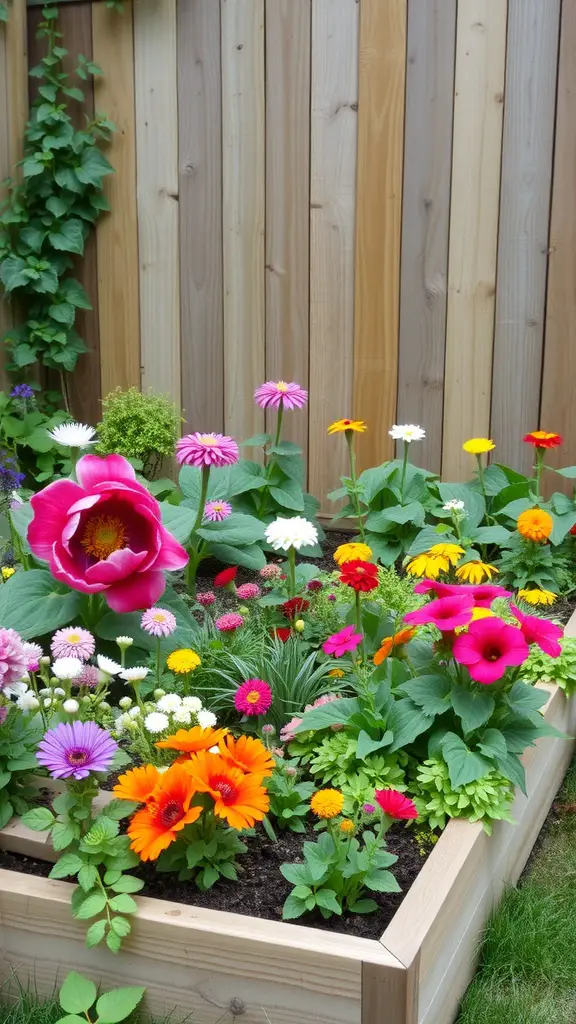
An L-shaped raised garden bed is a fantastic way to maximize your gardening space while adding a unique design element to your yard. This layout allows for easy access to plants from multiple angles, making it a practical choice for both novice and experienced gardeners.
In the image, you can see a vibrant display of flowers bursting with color. The raised bed is made from natural wood, which blends beautifully with the surrounding greenery. The arrangement of flowers creates a lively and inviting atmosphere, perfect for any garden.
This design not only enhances the aesthetic appeal of your outdoor space but also provides a structured environment for your plants. You can grow a variety of flowers and herbs, ensuring a diverse and colorful garden throughout the seasons.
When planning your L-shaped raised garden bed, consider the types of plants you want to include. Grouping flowers by height and color can create a stunning visual effect. Plus, the raised design makes it easier to maintain your plants, reducing the strain on your back while gardening.
Vertical Raised Garden Bed
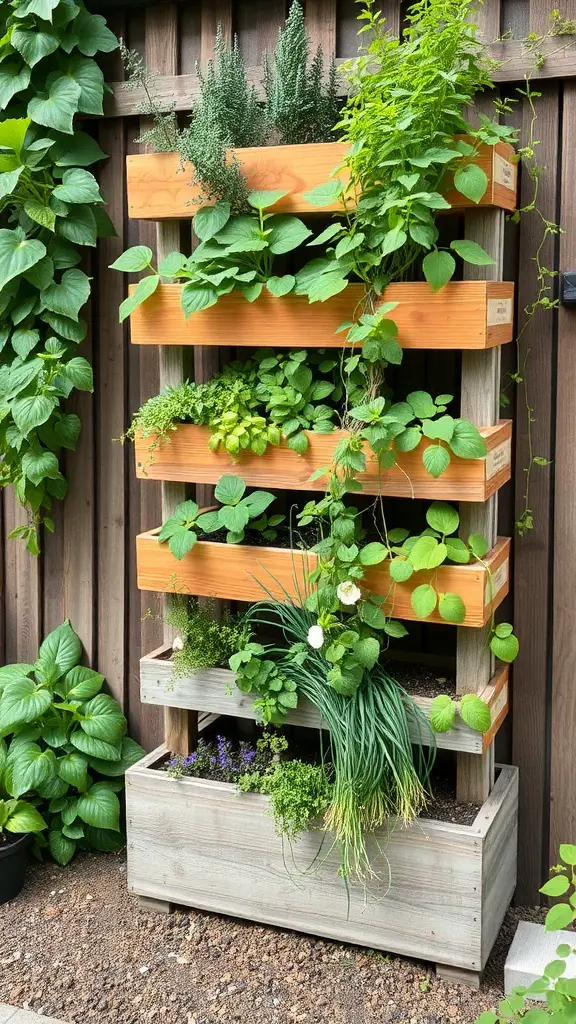
Vertical raised garden beds are a fantastic way to maximize space while adding beauty to your garden. This image shows a well-structured vertical garden that features multiple tiers of planters. Each tier is filled with a variety of plants, creating a lush and vibrant display.
The design allows for easy access to your plants, making it simple to tend to them without bending down or kneeling. This is especially helpful for those with limited mobility. The use of different plants adds texture and color, making the garden visually appealing.
In this setup, you can see herbs and leafy greens thriving, which are perfect for cooking. The vertical arrangement not only saves space but also encourages healthy growth by providing better air circulation and sunlight exposure.
Consider incorporating a vertical raised garden bed into your own space. It can fit in small backyards, patios, or even balconies. With a little creativity, you can create a stunning garden that is both functional and beautiful.
Horseshoe-Shaped Raised Bed
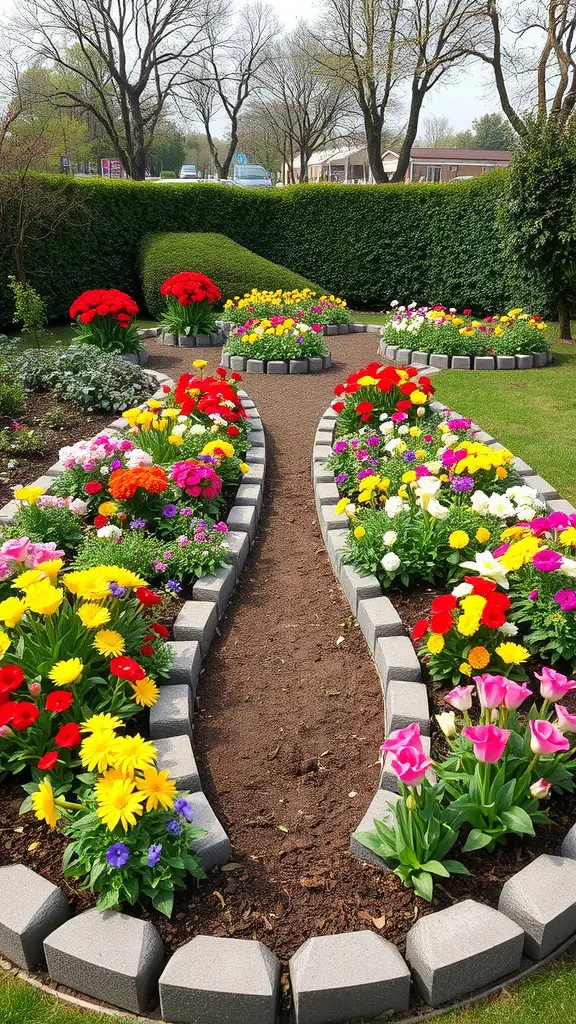
The horseshoe-shaped raised bed is a unique and inviting layout for any garden. This design creates a cozy nook that encourages interaction and accessibility. The curved edges make it easy to reach plants from all sides, which is perfect for those who love to tend to their flowers and vegetables.
In the image, you can see vibrant flowers blooming in a variety of colors, arranged neatly within the raised bed. The use of stones to outline the bed adds a clean and structured look, while the colorful blooms bring life and joy to the space. This layout not only maximizes planting area but also enhances the overall aesthetic of the garden.
One of the great things about a horseshoe-shaped bed is its versatility. You can plant herbs, vegetables, or flowers, depending on your preferences. The design also allows for companion planting, which can help improve growth and deter pests. Plus, the shape can easily fit into various garden sizes, making it a fantastic option for both small and large spaces.
Raised Garden Bed with Trellis
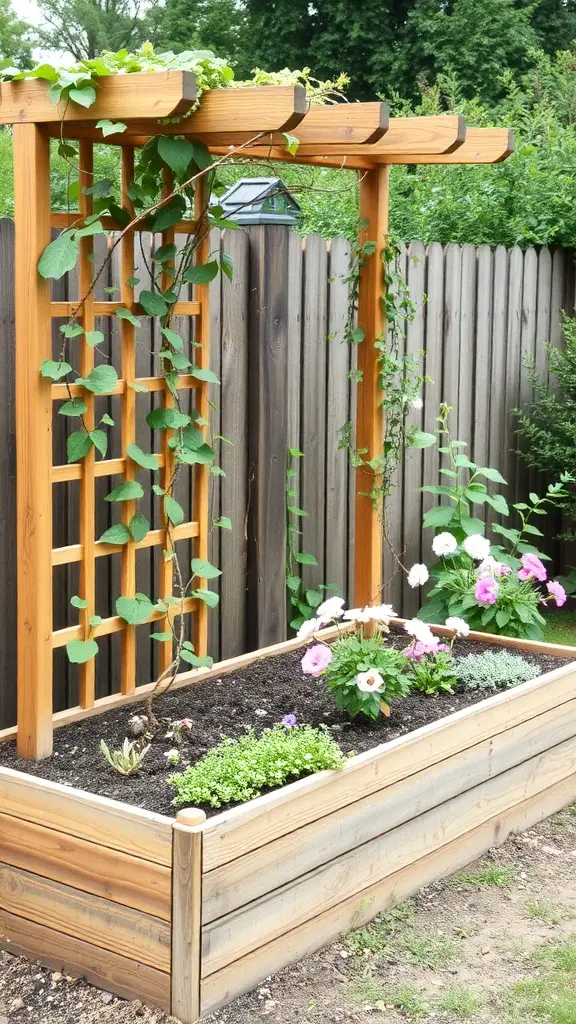
Raised garden beds with trellises are a fantastic way to maximize your gardening space. They not only provide a place for plants to grow but also add height and visual interest to your garden.
The image shows a beautifully constructed wooden raised bed, complete with a trellis. The trellis supports climbing plants, allowing them to grow upwards rather than outwards. This is especially useful for vegetables like cucumbers and beans, which thrive when given the chance to climb.
In the raised bed, you can see a variety of flowers and herbs. The colorful blooms bring life to the garden, while the herbs can be used in your kitchen. This combination makes the garden both functional and aesthetically pleasing.
Using a trellis can also help with air circulation around your plants, reducing the risk of disease. Plus, it makes harvesting easier since you can reach the fruits and vegetables without bending down too much.
Overall, a raised garden bed with a trellis is a smart choice for anyone looking to enhance their gardening experience. It’s a simple yet effective way to create a thriving garden.
Hexagonal Raised Garden Bed
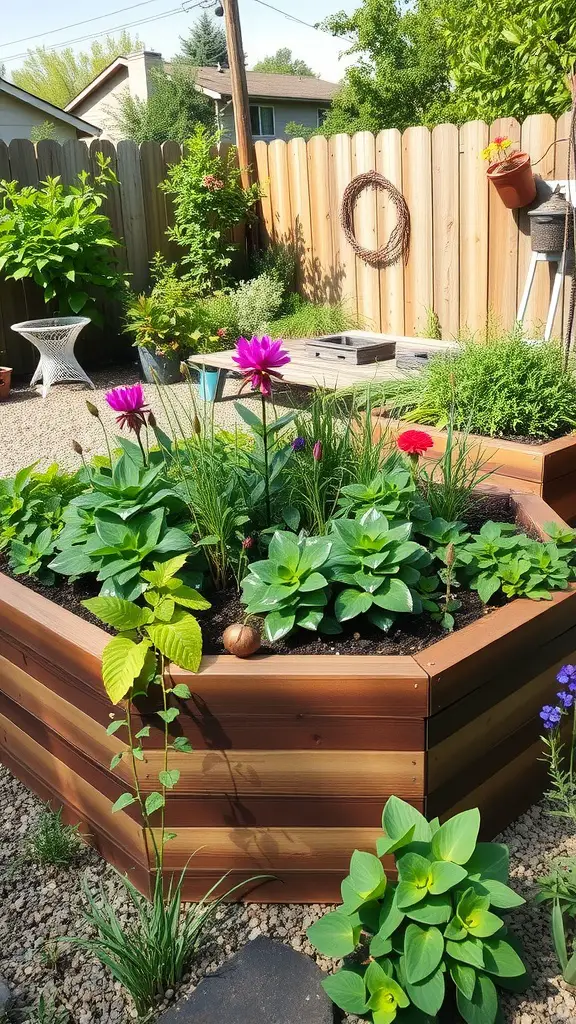
Hexagonal raised garden beds are a unique and stylish way to grow your plants. The shape allows for easy access from all sides, making gardening a breeze. This design not only maximizes space but also adds a visual appeal to your garden.
In the image, you can see a beautifully arranged hexagonal bed filled with vibrant flowers and lush greenery. The colorful blooms, like the pink and red flowers, create a lively atmosphere. The surrounding plants complement the main bed, enhancing the overall look of the garden.
Using a hexagonal layout can also help you experiment with different plant combinations. You can mix herbs, flowers, and vegetables, creating a diverse ecosystem right in your backyard. This layout encourages creativity and can make your gardening experience more enjoyable.
Setting up a hexagonal raised garden bed is straightforward. You can use wood, stone, or other materials to create the frame. Just ensure it’s sturdy enough to hold the soil and plants. Once built, fill it with quality soil and start planting your favorites!
Square Foot Gardening Layout
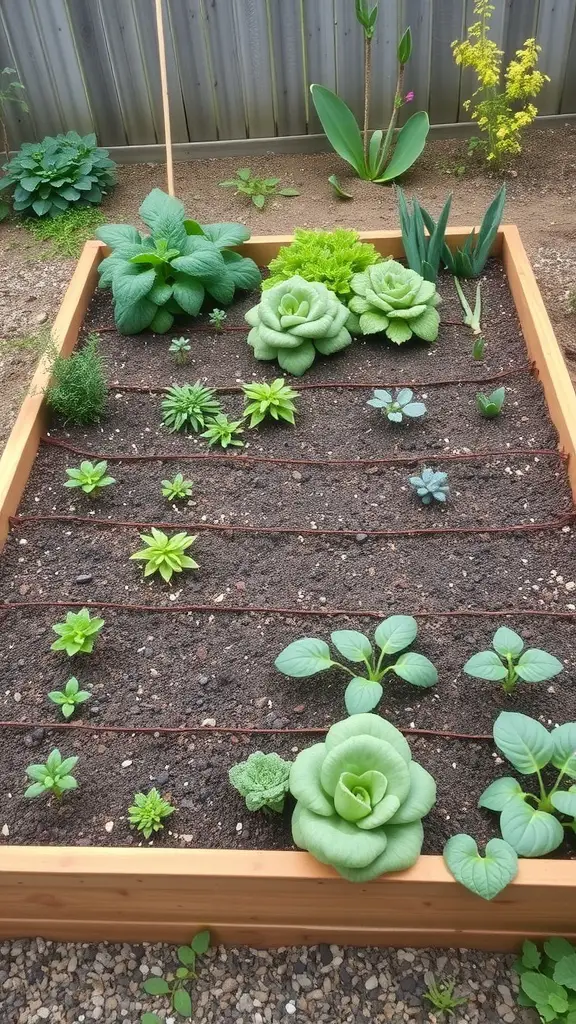
Square foot gardening is a smart way to maximize your growing space. In the image, you can see a raised garden bed divided into neat squares. Each square is planted with different types of vegetables and herbs. This layout makes it easy to manage and harvest your crops.
The arrangement allows for efficient use of space. For instance, larger plants like lettuce and cabbage are placed in one area, while smaller herbs and succulents occupy other squares. This way, every inch of the garden bed is utilized effectively.
Using this method, you can grow a variety of plants close together. It encourages companion planting, which can help deter pests and improve growth. Plus, it’s a fun way to experiment with different plants in a compact area!
Circular Raised Garden Bed
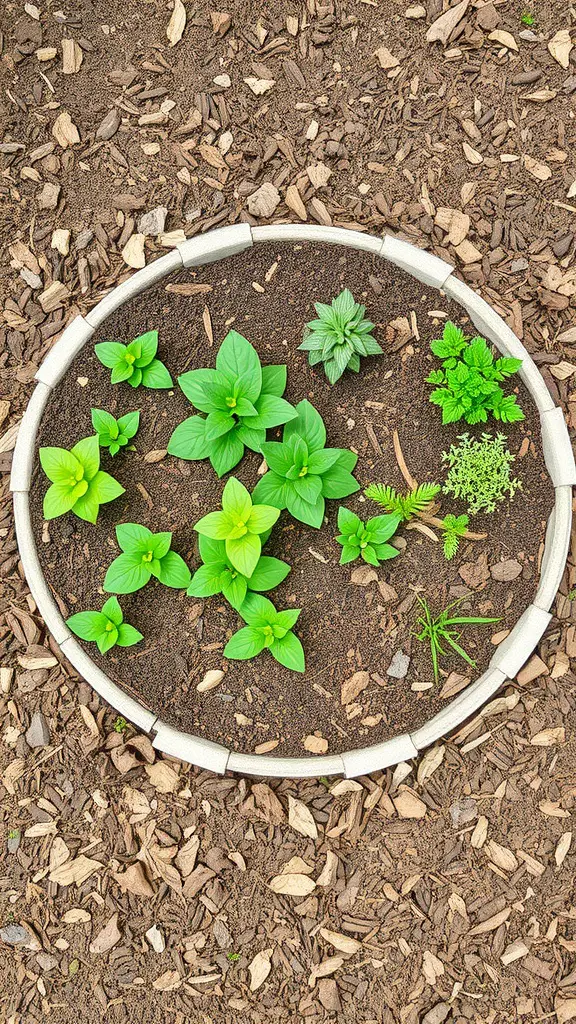
Circular raised garden beds are a charming way to grow your plants. They add a unique touch to your garden layout. This design allows for easy access to all your plants, making it simple to tend to them.
The image shows a circular bed filled with vibrant green plants. Each plant has its own space, promoting healthy growth. The circular shape helps in maximizing sunlight exposure, which is essential for plant health.
Using a circular layout can also create a focal point in your garden. It draws the eye and can be surrounded by pathways or other garden features. Plus, it’s a fun way to experiment with different plant arrangements.
Consider planting herbs, flowers, or vegetables in your circular bed. Mixing different types can create a visually appealing and functional garden space. This layout is perfect for small yards or even patios, making gardening accessible for everyone.
Tiered Raised Garden Bed
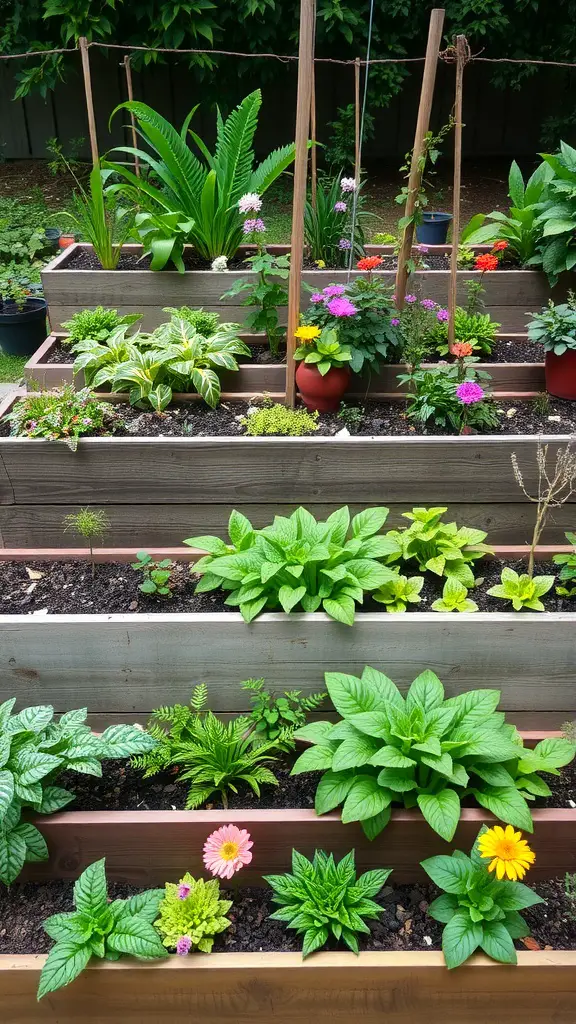
Tiered raised garden beds are a fantastic way to maximize space and create an eye-catching garden layout. This design allows you to grow a variety of plants at different heights, making it easier to tend to them and adding visual interest to your garden.
The image shows a beautifully arranged tiered garden bed with several levels. Each tier is filled with lush greenery and colorful flowers, showcasing a mix of plants that thrive together. The varying heights not only make it easier to access the plants but also create a stunning display that can be enjoyed from different angles.
Incorporating a tiered design can also help with drainage and sunlight exposure. The higher tiers can receive more sunlight, which is perfect for sun-loving plants, while the lower tiers can accommodate shade-tolerant varieties. This thoughtful arrangement allows for a diverse garden that can flourish throughout the seasons.
When planning your tiered raised garden bed, consider the types of plants you want to grow. Mixing flowers with herbs and vegetables can create a vibrant and functional space. Plus, the added height can deter some pests, making it easier to maintain your garden.
Raised Bed with Pathways
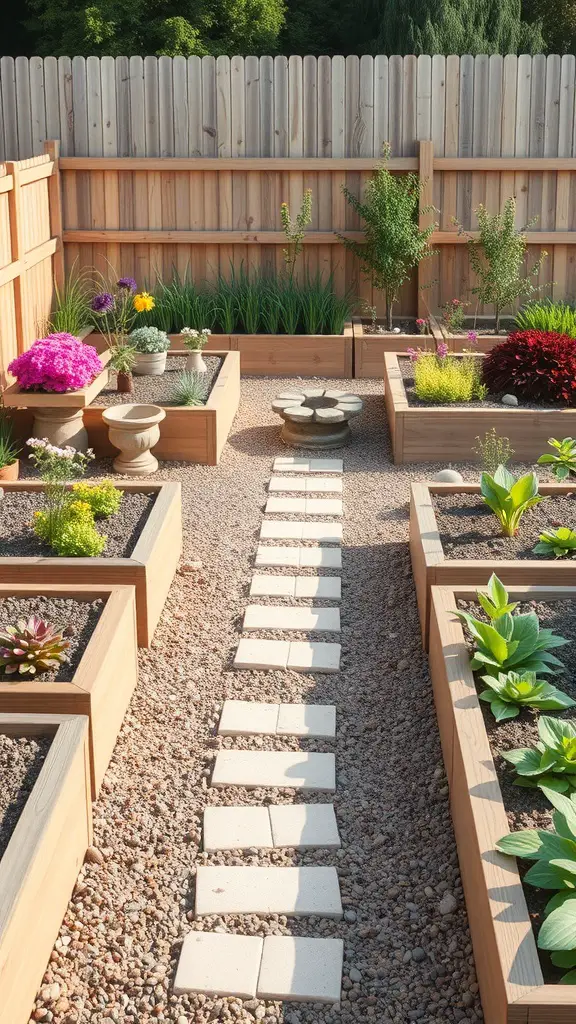
Creating a raised garden bed layout with pathways is a smart way to organize your gardening space. The image shows a neat arrangement of raised beds, surrounded by a pathway made of stepping stones. This setup not only looks appealing but also makes it easy to access your plants.
The pathways allow you to walk comfortably between the beds, minimizing soil compaction. This is important for healthy plant growth. The stones provide a stable surface, making it easier to tend to your garden without stepping on the soil directly.
In the image, you can see various plants and flowers in the raised beds, adding color and life to the garden. The combination of greenery and the earthy tones of the stones creates a lovely contrast. This layout is perfect for anyone looking to maximize their gardening potential while keeping things organized and beautiful.
U-Shaped Raised Garden Bed
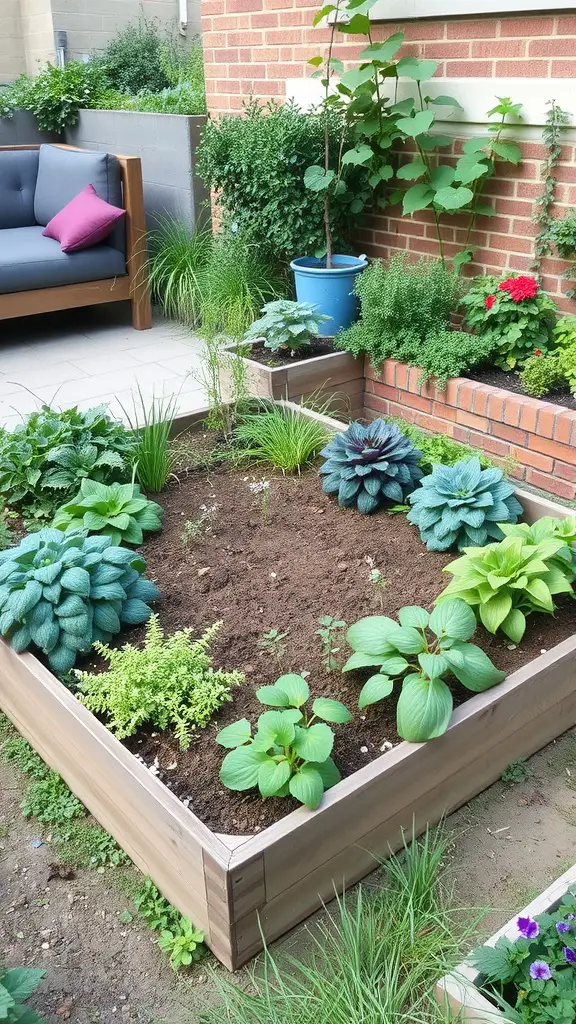
A U-shaped raised garden bed is a fantastic way to maximize space while creating an inviting gardening area. This layout allows for easy access to plants from all sides, making it perfect for small gardens or patios.
The image shows a well-organized U-shaped bed filled with a variety of plants. The lush greenery adds a vibrant touch to the space, while the wooden frame keeps everything neat and tidy. This design not only looks great but also encourages healthy plant growth.
Incorporating a U-shaped bed can enhance your gardening experience. You can easily reach your plants without stepping on soil, which helps maintain soil structure. Plus, it creates a cozy nook for sitting and enjoying your garden.
Consider adding herbs or colorful flowers to your U-shaped garden bed. This will not only make it visually appealing but also attract beneficial insects. With the right plants, you can create a thriving ecosystem right in your backyard.
Raised Garden Bed for Pollinator Plants
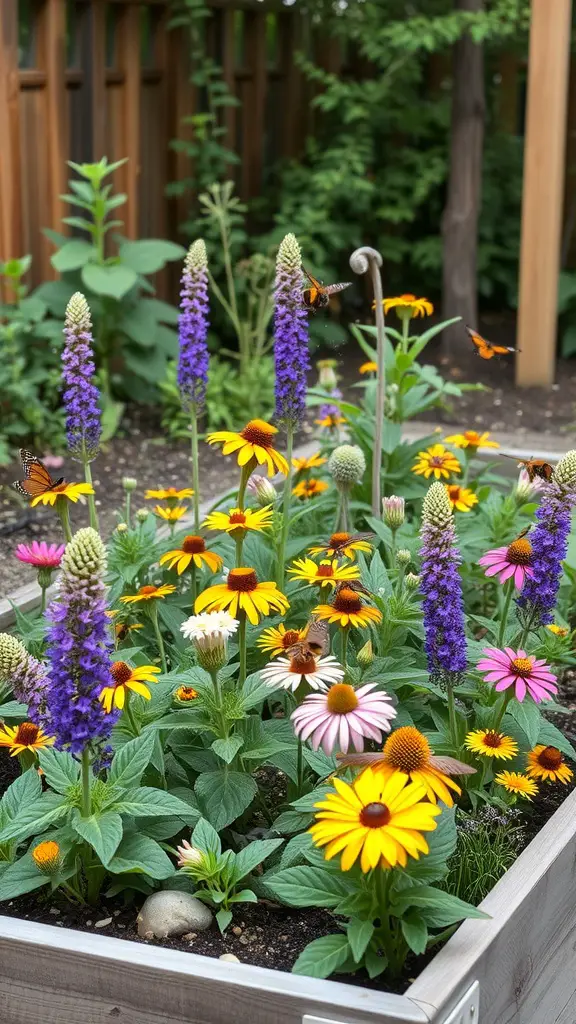
Creating a raised garden bed filled with pollinator plants is a delightful way to support local wildlife. In the image, you can see a vibrant mix of flowers, including purple spikes and cheerful yellow daisies. These plants attract bees, butterflies, and other pollinators, making your garden a lively spot. The raised bed design not only looks great but also makes it easier to tend to your plants. You can enjoy the beauty of the flowers while knowing you’re helping the environment. Plus, the variety of colors and shapes adds a nice touch to your outdoor space.
Garden Bed with Built-in Seating
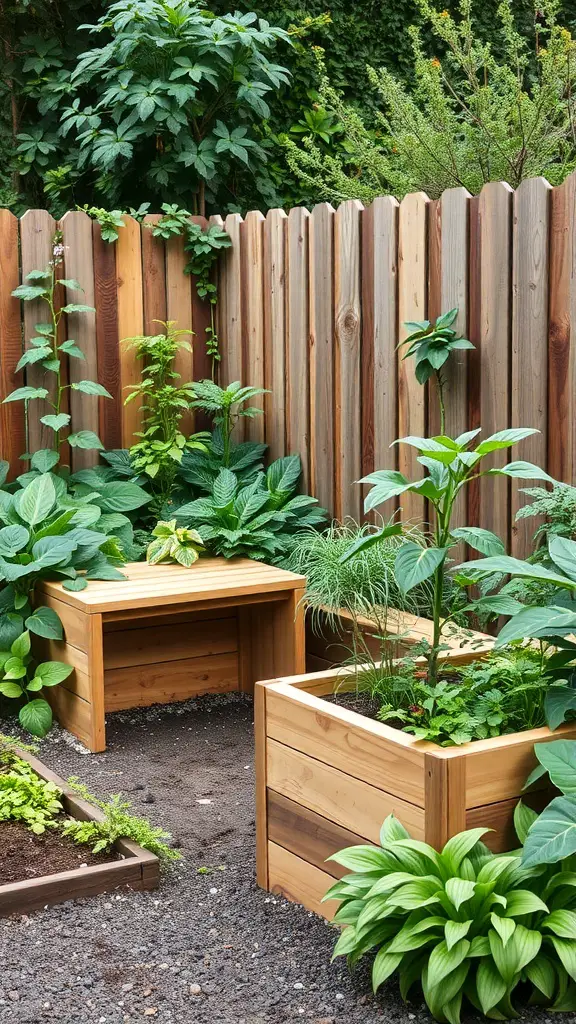
Imagine a cozy corner in your garden where you can relax and enjoy the beauty of your plants. A garden bed with built-in seating is a fantastic way to combine functionality with comfort. This setup not only provides space for growing vegetables or flowers but also creates a spot to unwind.
The image shows a lovely design featuring wooden raised beds that double as seating. The natural wood blends beautifully with the greenery surrounding it. You can easily picture yourself sitting here, sipping a cup of tea while tending to your plants.
Incorporating built-in seating into your garden layout encourages you to spend more time outdoors. It’s a perfect place for family gatherings or simply enjoying a quiet moment. You can choose to add cushions for extra comfort or keep it simple for a rustic feel.
Overall, this design idea is practical and inviting. It transforms your garden into a welcoming retreat where you can connect with nature.
Companion Planting Layout
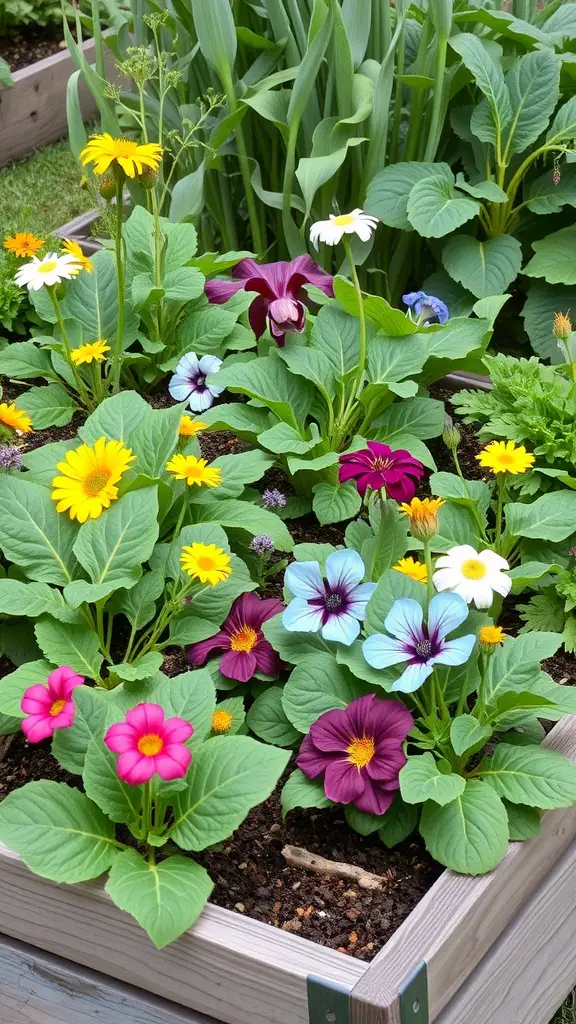
Companion planting is a fun way to maximize your garden’s potential. In this layout, you can see a vibrant mix of flowers and greens. The colorful blooms not only brighten up the space but also attract beneficial insects.
In the image, you’ll notice a variety of flowers like daisies and pansies intermingled with leafy greens. This combination helps create a balanced ecosystem in your raised garden bed. The flowers can deter pests while the greens provide a nutritious harvest.
When planning your layout, think about how different plants can support each other. For example, marigolds are known to repel nematodes, making them great companions for many vegetables. Mixing flowers with your veggies can also enhance pollination, leading to a more fruitful garden.
Keep in mind the growth habits of your plants. Taller plants can provide shade for shorter ones, creating a microclimate that benefits all. This layout not only looks appealing but also promotes a healthy growing environment.
Multi-Level Raised Garden
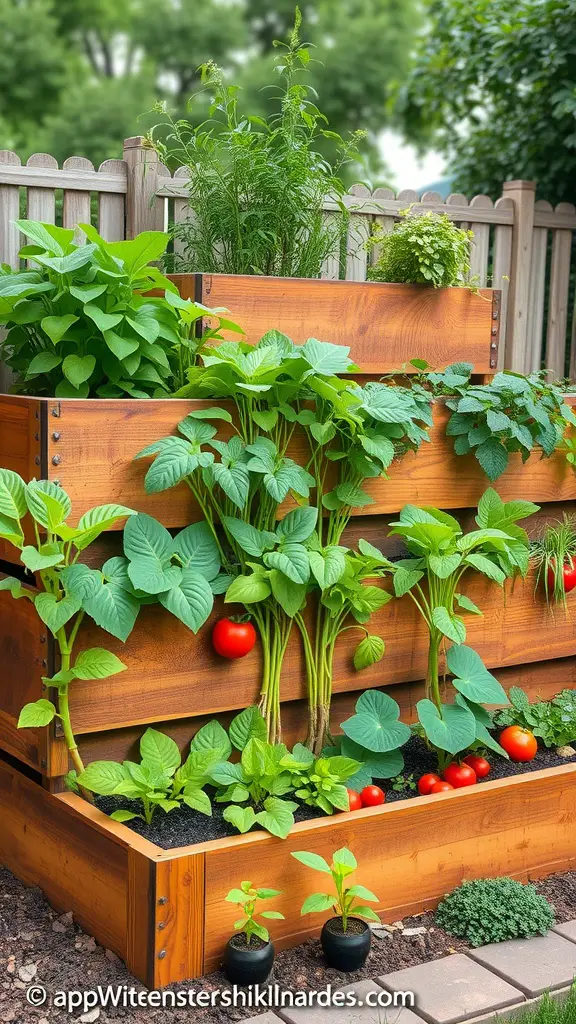
Multi-level raised gardens are a fantastic way to maximize space and create a visually appealing layout. This design features several tiers, allowing you to grow a variety of plants in a compact area. Each level can host different types of plants, from herbs to vegetables, making it easy to organize your garden.
The image showcases a beautifully constructed multi-level raised garden. The wooden beds are stacked, providing a unique look while ensuring easy access to each tier. The vibrant green plants, including tomatoes and leafy greens, thrive in this setup. This arrangement not only enhances the aesthetic of your garden but also promotes better drainage and sunlight exposure for each plant.
With a multi-level design, you can experiment with different plant heights and colors. It’s a great way to add depth and interest to your garden space. Plus, it makes gardening more accessible, especially for those who may have difficulty bending down to ground level.
Children’s Garden Bed
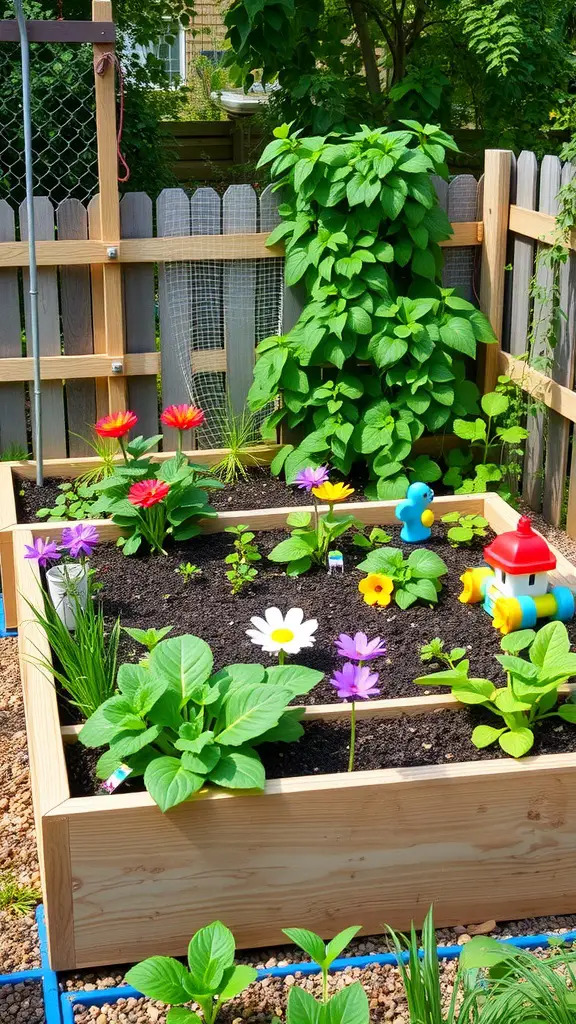
Creating a children’s garden bed can be a fun and rewarding project. The image shows a vibrant raised garden bed filled with colorful flowers and playful decorations. This setup invites kids to explore and learn about plants in a hands-on way.
The wooden frame of the garden bed is sturdy and safe for little hands. Bright flowers like daisies and purple blooms add a cheerful touch. These plants are not just pretty; they can also attract butterflies, making the garden a lively spot for kids to observe nature.
Incorporating toys, like the colorful house in the corner, makes the garden even more engaging. It sparks imagination and encourages children to spend time outdoors. A garden like this can teach kids about responsibility as they help with watering and caring for the plants.
Overall, a children’s garden bed is a wonderful way to introduce kids to gardening. It fosters a love for nature and provides a space for creativity and learning.
Sunken Raised Garden Bed
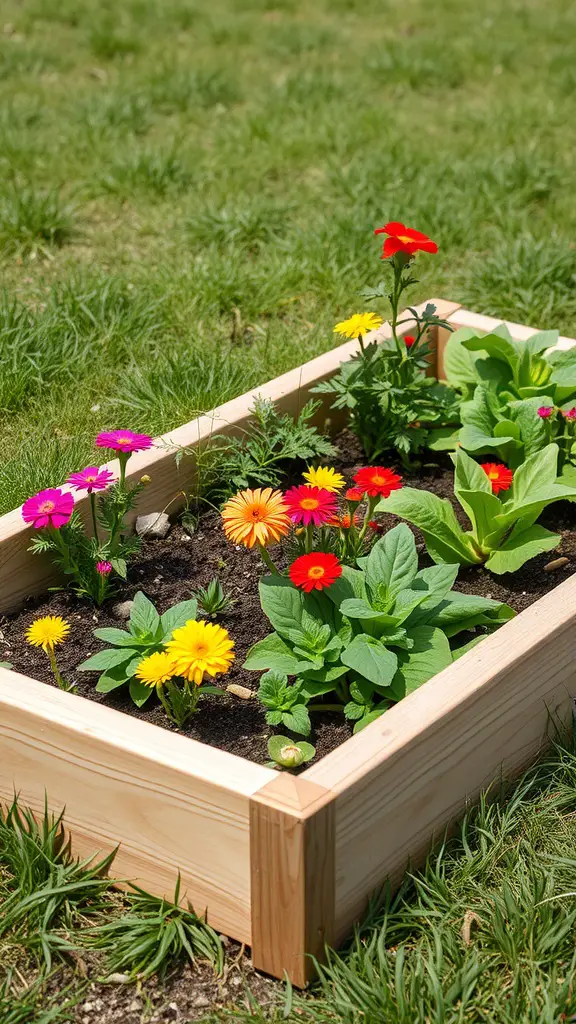
Sunken raised garden beds are a fantastic way to create a unique gardening space. They blend seamlessly into the landscape, giving a natural look while providing excellent drainage and soil quality. This design allows for easy access to plants, making gardening more enjoyable.
In the image, you can see a beautifully arranged sunken raised garden bed filled with vibrant flowers. The colorful blooms bring life to the garden, showcasing how effective this layout can be. The wooden frame is sturdy and complements the surrounding grass, enhancing the overall aesthetic.
One of the great benefits of sunken beds is that they can help retain moisture, which is perfect for various plants. The depth of the bed allows for better root growth, leading to healthier plants. Plus, they can be a great way to showcase your favorite flowers or even vegetables.
Consider adding a mix of perennials and annuals to keep the garden lively throughout the seasons. With a little planning, your sunken raised garden bed can become a stunning focal point in your yard.
Raised Bed with Drip Irrigation
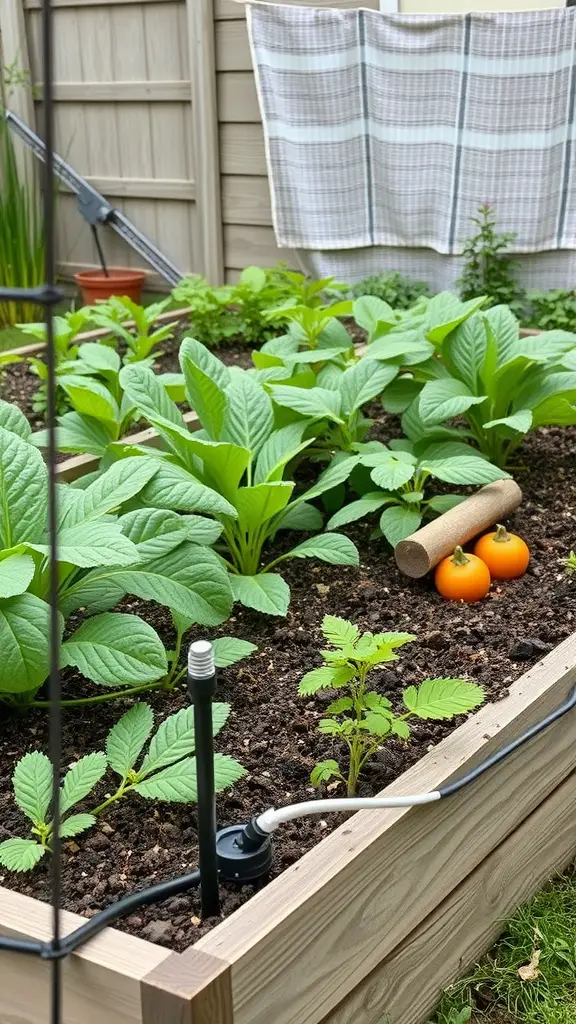
Raised beds are a fantastic way to grow your own vegetables and flowers. They offer better drainage and soil quality. Adding a drip irrigation system can take your gardening to the next level.
In the image, you can see a lush raised bed filled with vibrant green plants. The drip irrigation system is visible, with black tubing running through the soil. This setup ensures that each plant receives just the right amount of water, reducing waste and keeping the soil consistently moist.
Alongside the plants, there are some bright orange tomatoes peeking through. They add a pop of color and promise a delicious harvest. The wooden frame of the raised bed looks sturdy and well-constructed, making it a great addition to any garden.
Using drip irrigation not only saves time but also helps in maintaining healthy plants. It’s a simple way to ensure your garden thrives without constant watering. If you’re considering a raised bed, think about incorporating this efficient watering method!
Shade-Tolerant Plant Layout
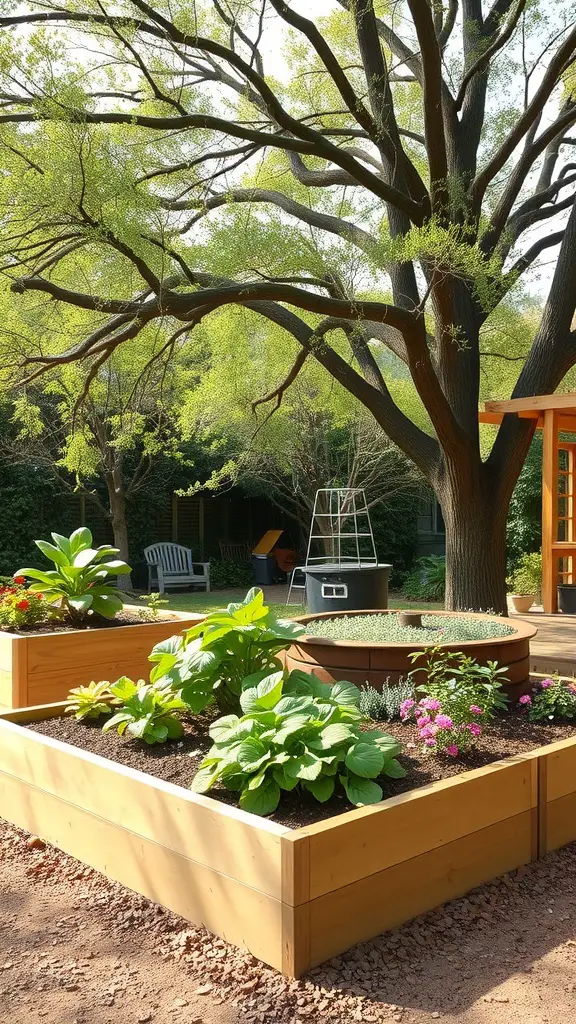
Creating a shade-tolerant garden bed can be a rewarding experience. In the image, you can see a beautiful layout of raised garden beds that thrive under the gentle shade of a large tree. This setup is perfect for plants that prefer less sunlight.
The raised beds are filled with a variety of lush greenery, including hostas and colorful flowers. These plants not only add beauty but also create a vibrant atmosphere in the shaded area. The design encourages a cozy feel, making it an inviting spot to relax.
When planning your own shade garden, think about the types of plants that will flourish in lower light. Some great options include ferns, astilbes, and certain types of begonias. Mixing different textures and colors can enhance the visual appeal of your garden.
Remember to consider the layout of your beds. Placing taller plants at the back and shorter ones in the front can create depth. This arrangement allows each plant to shine without overshadowing its neighbors. With a little planning, your shade garden can become a stunning retreat.
Herb Spiral Raised Bed
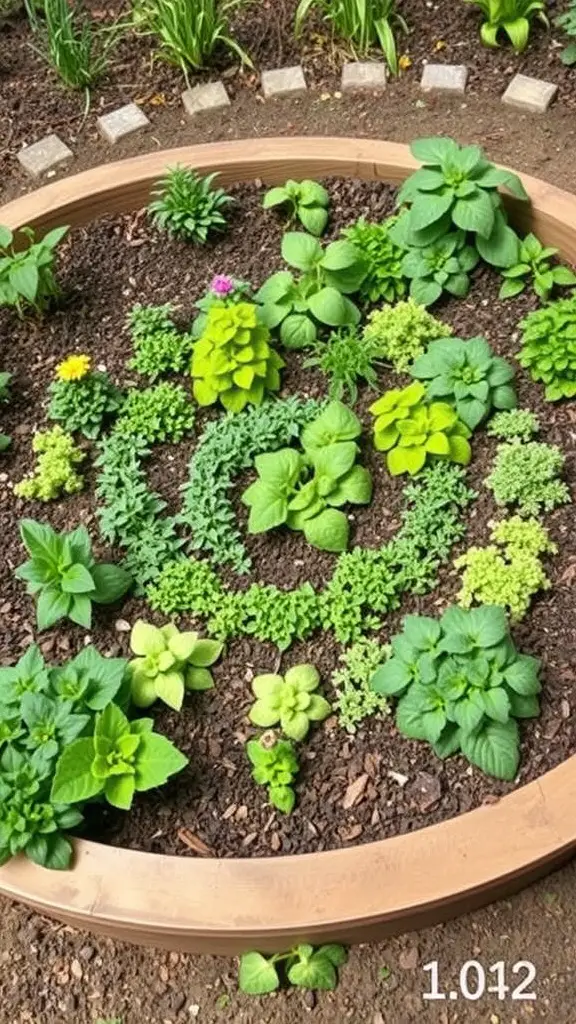
Herb spirals are a fun and efficient way to grow a variety of herbs in a small space. This design features a circular layout that spirals upwards, allowing for different microclimates within the same bed. The image shows a vibrant herb spiral filled with lush green plants, showcasing a mix of textures and colors.
The spiral design not only looks appealing but also maximizes sunlight exposure and drainage. The higher sections can accommodate herbs that prefer drier conditions, while the lower areas can hold moisture-loving plants. This setup encourages biodiversity and makes it easy to access your herbs from all sides.
Incorporating stones or bricks around the spiral can enhance its structure and provide a neat border. This also helps in maintaining the shape of the bed while adding an aesthetic touch. Whether you’re a seasoned gardener or just starting out, a herb spiral can be a delightful addition to your garden.
Pollinator-Friendly Raised Bed
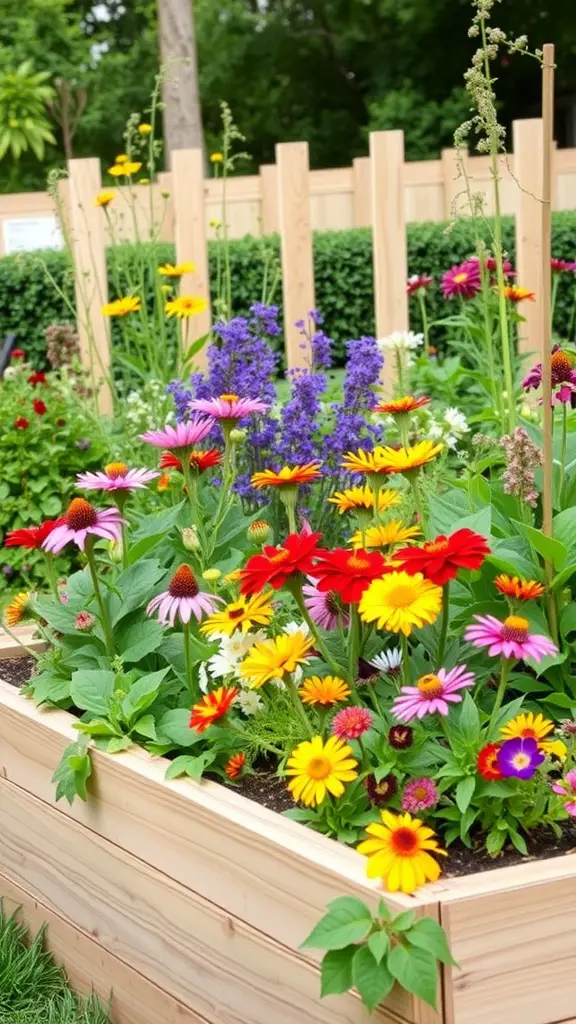
Creating a pollinator-friendly raised bed is a fantastic way to support local wildlife while enjoying a burst of color in your garden. The image shows a vibrant raised bed filled with a variety of flowers, including daisies and coneflowers. These plants attract bees, butterflies, and other pollinators, making your garden a lively ecosystem.
When planning your layout, consider mixing different flower types to provide continuous blooms throughout the growing season. This ensures that pollinators have a reliable food source. The raised bed’s wooden structure not only looks great but also helps with drainage and soil quality, making it easier to maintain.
Incorporating native plants is another great idea. They are adapted to your local environment and often require less maintenance. Plus, they are more attractive to local pollinators. By creating a pollinator-friendly raised bed, you contribute to biodiversity and create a beautiful space to enjoy.
Edible Flower Raised Bed
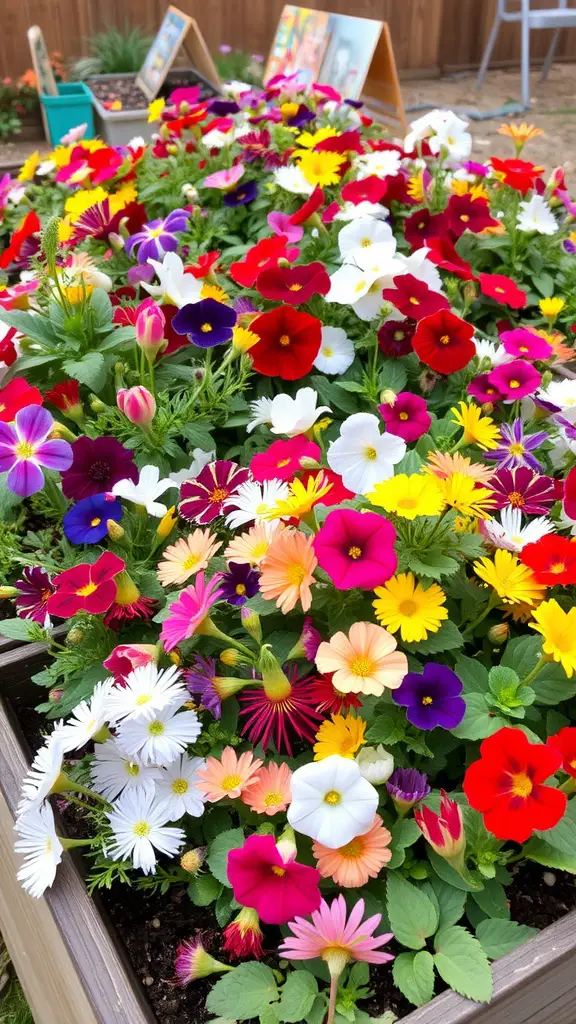
Creating an edible flower raised bed is a delightful way to add color and flavor to your garden. The image showcases a vibrant mix of flowers, each with its unique charm. These blooms not only beautify your space but can also be used in various dishes.
Consider planting flowers like nasturtiums, pansies, and marigolds. They are not only stunning but also edible. You can toss them into salads for a pop of color or use them as garnishes for desserts. The bright hues in the image highlight how these flowers can transform a simple dish into something special.
When planning your layout, think about the height and spread of each flower. Taller blooms can go in the back, while shorter ones can fill in the front. This arrangement ensures that every flower gets the sunlight it needs. Plus, it creates a visually appealing display.
Don’t forget to consider the soil and sunlight requirements for your flowers. Most edible flowers thrive in well-drained soil and need plenty of sunlight. Regular watering will keep them looking fresh and vibrant. Enjoy the process of planting and watching your edible flower bed flourish!
Raised Bed with Water Feature
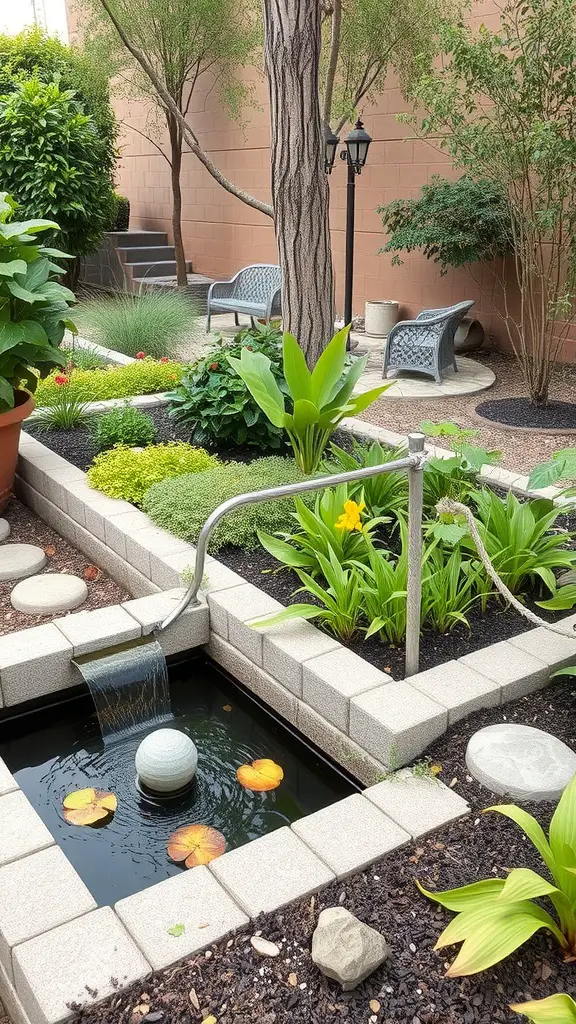
A raised bed with a water feature can truly elevate your garden space. Imagine a peaceful corner where you can unwind, surrounded by lush greenery and the soothing sound of flowing water.
The image showcases a beautifully designed raised bed that incorporates a small water feature. The gentle waterfall adds a calming touch, making it an inviting spot to relax. The water flows gracefully into a small pond, creating a serene atmosphere.
Surrounding the water feature, vibrant plants thrive, adding color and life to the space. The combination of the raised bed and water creates a balanced layout, perfect for both aesthetics and functionality. You can grow your favorite herbs or flowers in the raised bed while enjoying the tranquil view of the water.
Consider adding seating nearby to make this area a perfect retreat. Whether you want to sip your morning coffee or read a book, this setup offers a cozy escape right in your backyard.
Garden Bed with Decorative Edging
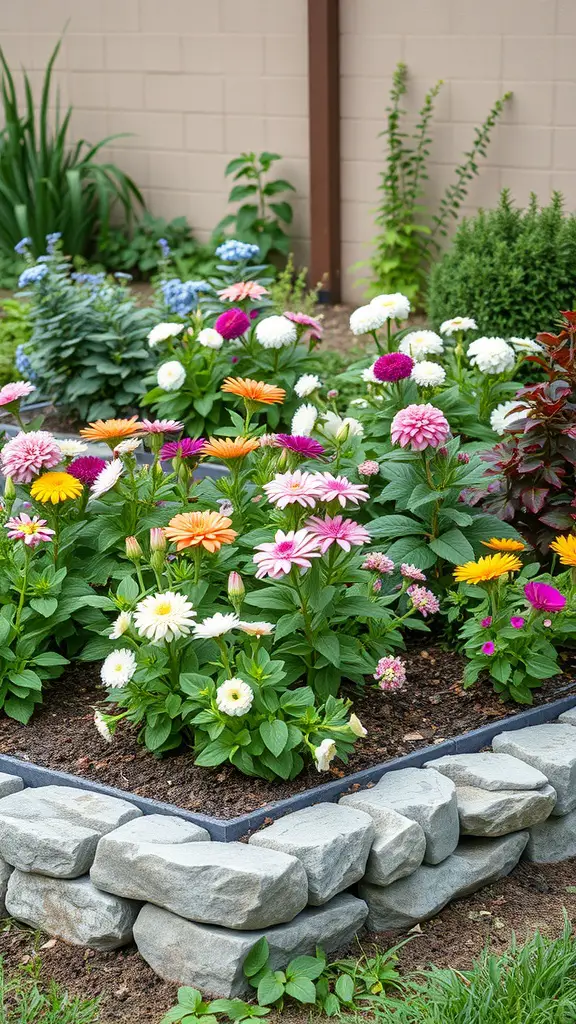
Creating a garden bed with decorative edging can really enhance the look of your outdoor space. The image shows a vibrant flower bed surrounded by a sturdy stone border. This not only adds a neat finish but also helps to keep the soil in place.
The colorful blooms, including pinks, yellows, and whites, bring life and cheer to the garden. Using a variety of flowers can create a stunning visual effect. It’s a great way to express your creativity while enjoying the beauty of nature.
Choosing the right edging material is key. The stone used here is both functional and attractive. It provides a natural look that blends well with the plants. Plus, it can help prevent weeds from creeping into your flower bed. Overall, this layout is a fantastic idea for anyone looking to spruce up their garden.
Compost Integrated Raised Bed
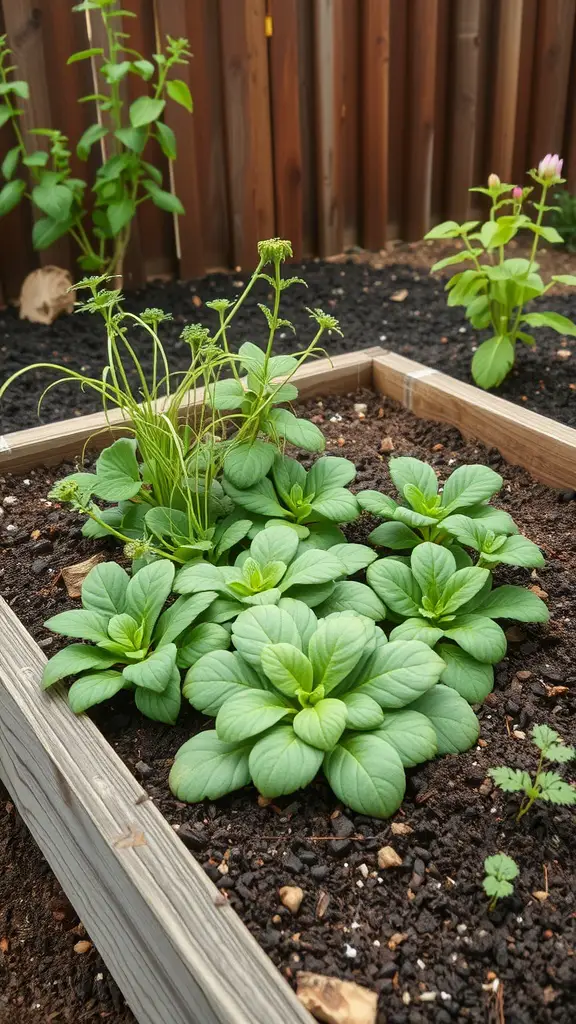
Compost integrated raised beds are a fantastic way to combine gardening with sustainable practices. In the image, you can see a beautifully arranged raised bed filled with vibrant green plants. The plants are thriving, thanks to the rich compost that nourishes the soil.
Using compost in your raised beds not only improves soil quality but also helps retain moisture. This means less frequent watering, which is a win for busy gardeners. The wooden frame of the raised bed adds a rustic charm, making it a lovely addition to any garden.
To create your own compost integrated raised bed, start by layering organic materials like kitchen scraps, yard waste, and leaves at the bottom. Then, fill the bed with a mix of compost and soil. This setup encourages healthy plant growth while recycling waste. It’s a simple yet effective way to enhance your gardening experience!
Sustainable Raised Bed Design
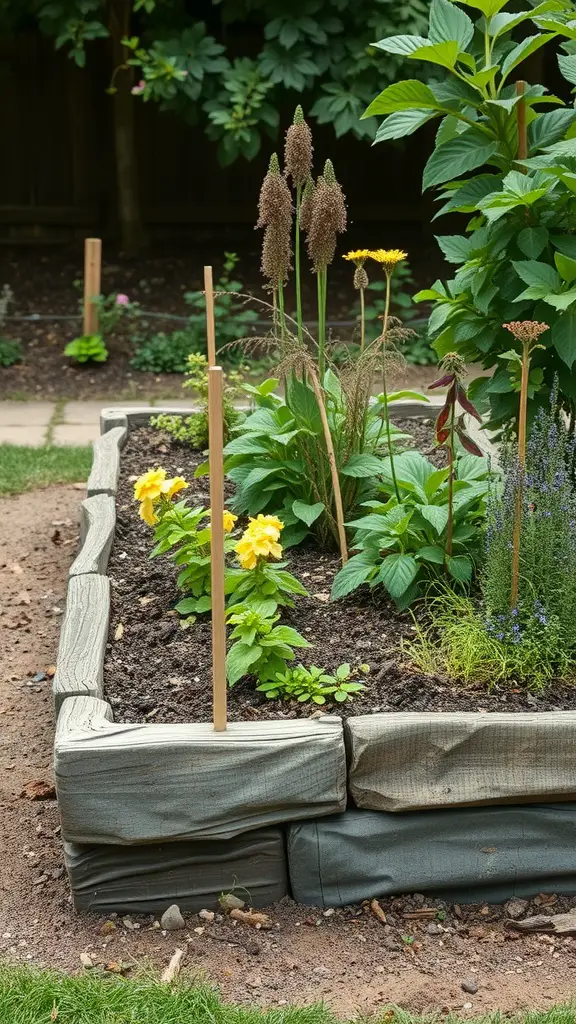
Raised garden beds are a fantastic way to grow plants while keeping sustainability in mind. The image shows a well-structured raised bed filled with vibrant flowers and greenery. The design is not just about aesthetics; it also promotes healthy plant growth.
Using natural materials for the bed’s structure can help reduce environmental impact. In the image, the wooden edges provide a rustic look while being functional. This setup allows for better drainage and soil management, which is key for a thriving garden.
Incorporating native plants, like the ones seen here, can attract local pollinators and support biodiversity. The colorful flowers add beauty and serve a purpose, making the garden both appealing and eco-friendly.
Adding stakes can help support taller plants, ensuring they grow strong and healthy. This thoughtful design approach not only enhances the garden’s visual appeal but also contributes to a sustainable ecosystem.
Raised Bed with Mulch Pathways
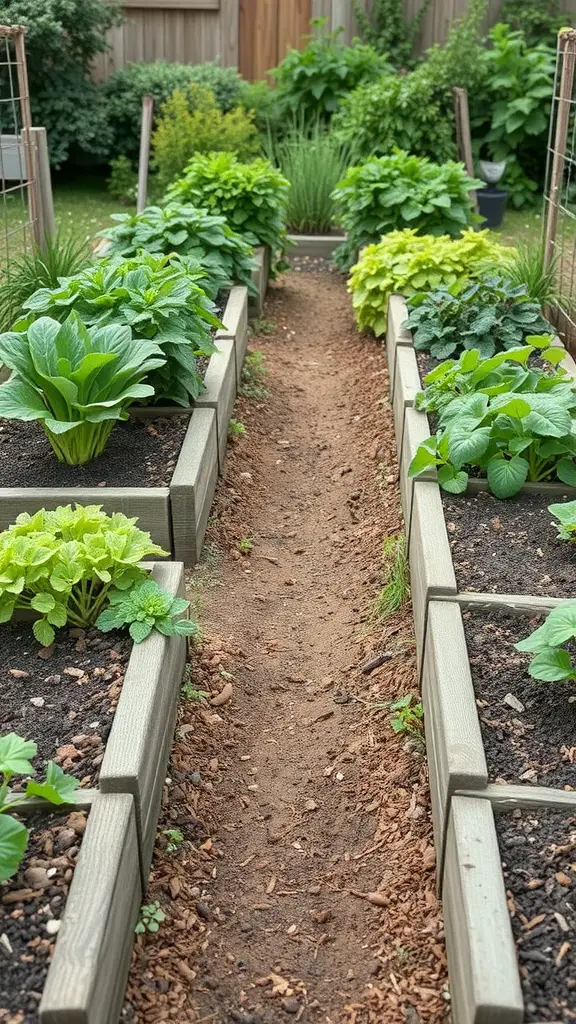
Raised garden beds are a fantastic way to grow your plants while keeping everything organized. In this layout, the beds are lined with a clear pathway made of mulch, making it easy to navigate through your garden.
The mulch pathways not only look great but also help with moisture retention and weed control. This means less maintenance for you and healthier plants overall.
Each raised bed is filled with vibrant greens, showcasing a variety of plants. The contrast between the lush foliage and the earthy tones of the mulch creates a welcoming space for gardening enthusiasts.
Having designated pathways allows you to tend to your plants without stepping on the soil in the beds. This keeps the soil structure intact and promotes better growth. Plus, it adds a neat and tidy appearance to your garden.
Consider using different types of mulch, like wood chips or straw, to add texture and color to your pathways. This can enhance the overall look of your garden while providing practical benefits.
Rock Garden Raised Bed
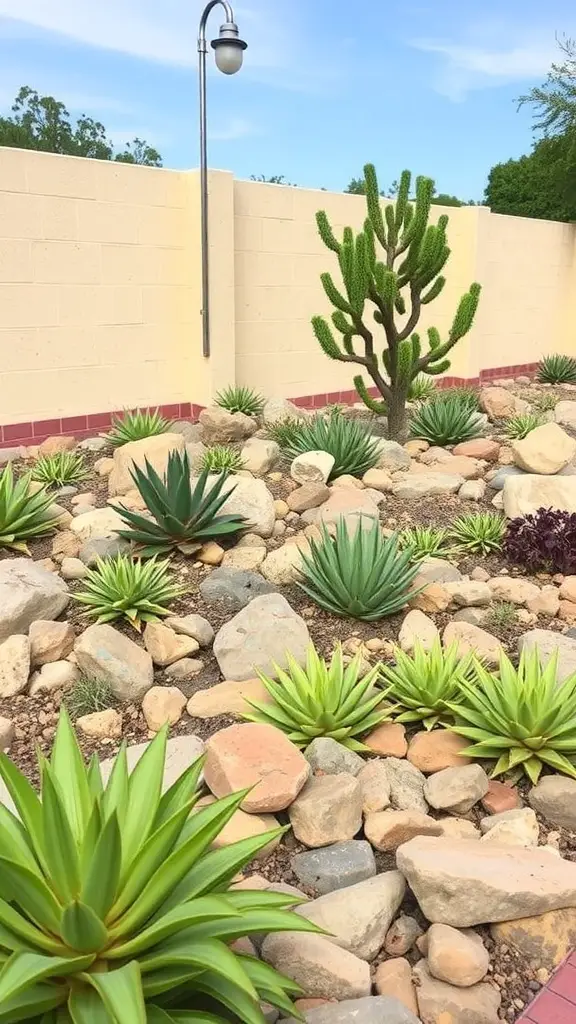
A rock garden raised bed is a fantastic way to bring a touch of nature to your outdoor space. This layout features a mix of rocks and plants, creating a natural look that is both beautiful and low-maintenance.
In the image, you can see a variety of succulents and cacti nestled among smooth stones. The plants are arranged in a way that highlights their unique shapes and colors. This design not only looks great but also allows for excellent drainage, which is essential for these types of plants.
The use of rocks adds texture and depth to the garden. They can be arranged in different patterns to create pathways or focal points. The tall cactus stands out, drawing the eye and adding height to the layout.
Rock gardens are perfect for areas with low rainfall. They require less water and are easier to care for than traditional gardens. Plus, they attract pollinators, making your garden lively and vibrant.
If you’re considering a rock garden raised bed, think about the types of plants you want to include. Succulents, agaves, and other drought-resistant plants thrive in this setting. With a little planning, you can create a stunning garden that enhances your outdoor area.
Pollinator Habitat Raised Bed
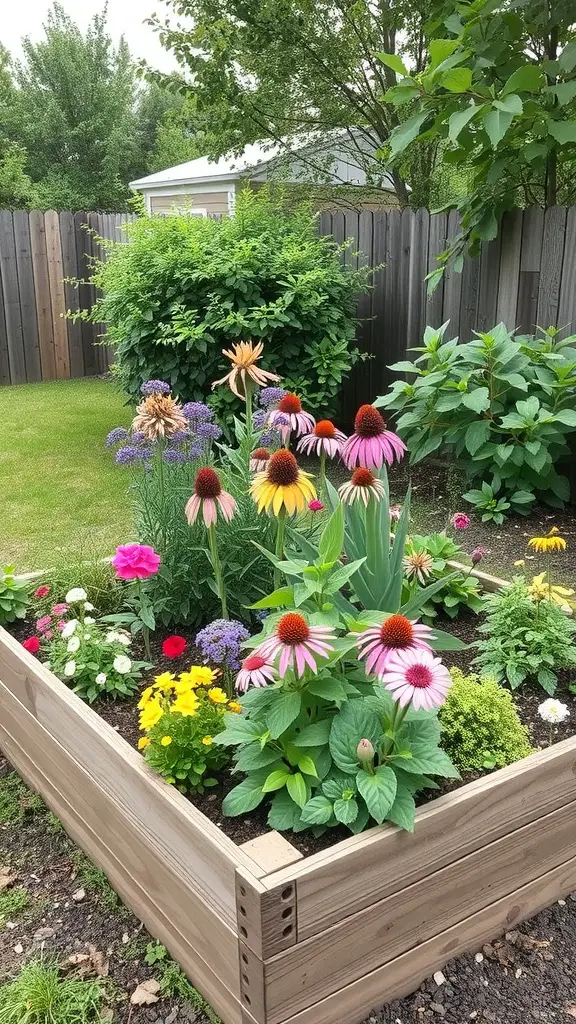
A pollinator habitat raised bed is a fantastic way to support local wildlife while adding beauty to your garden. This image showcases a vibrant raised bed filled with colorful flowers, perfect for attracting bees, butterflies, and other pollinators.
The mix of plants, including Echinacea and various annuals, creates a lively environment. These flowers not only look great but also provide essential nectar and pollen for pollinators. The raised bed design makes it easy to maintain and ensures good drainage, which is vital for healthy plants.
Incorporating native plants can further enhance this habitat. Native species are often more attractive to local pollinators and require less maintenance. Consider adding a variety of heights and colors to create visual interest and a welcoming space for these important creatures.
Creating a pollinator habitat raised bed is a rewarding project. It encourages biodiversity in your garden and offers a peaceful spot to enjoy nature. Plus, watching pollinators at work can be a delightful experience!
Raised Bed with Seasonal Rotation
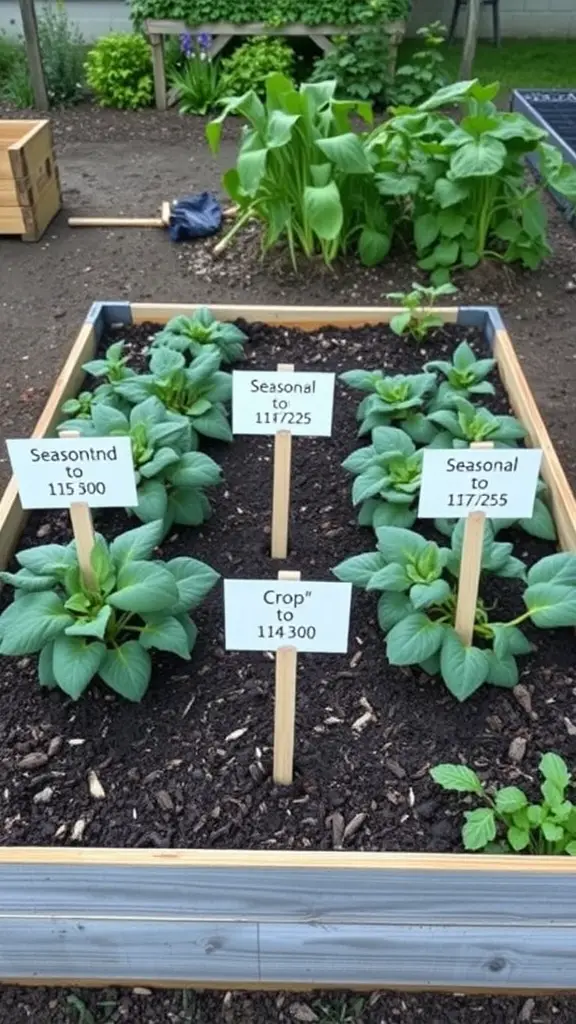
In this raised bed, you can see a thoughtful layout that promotes seasonal rotation. Each section is clearly marked with signs indicating the type of crop and its specific planting season. This method helps in managing soil health and maximizing yield.
The plants are arranged neatly, allowing for easy access and maintenance. The use of wooden stakes for labeling is a simple yet effective way to keep track of what’s planted where. This can be especially helpful for beginners who are still learning about different plant needs.
Seasonal rotation is key to preventing soil depletion and pest buildup. By changing what you plant in each section, you give the soil a chance to recover and replenish nutrients. This practice not only supports healthy plants but also enhances the overall productivity of your garden.
Incorporating seasonal rotation into your raised bed design can lead to a thriving garden. It’s a fun way to experiment with different crops throughout the year while keeping your garden fresh and vibrant.
Raised Bed with Climbing Vegetables
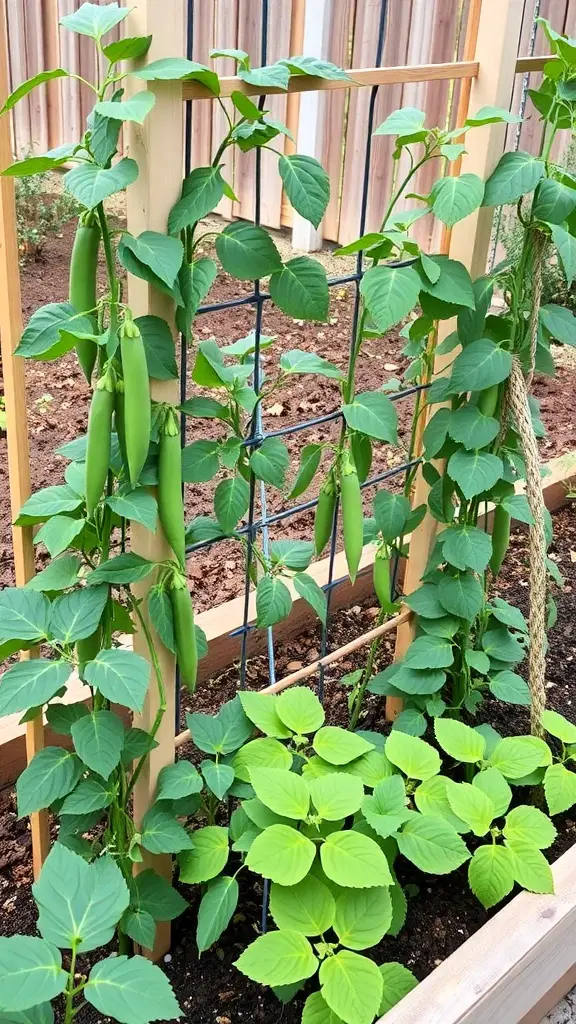
Raised beds are a fantastic way to grow climbing vegetables. They not only save space but also make harvesting easier. In the image, you can see a sturdy trellis supporting vibrant green pea plants. These climbing vegetables thrive when given vertical space, allowing them to reach for the sun.
The trellis provides support, ensuring the plants grow upright. This helps with air circulation and keeps the vegetables clean. Below the peas, there are lush green leaves of another plant, adding a nice contrast to the scene. This layout maximizes the use of space in the garden.
When planning your raised bed, think about which climbing vegetables you want to grow. Peas, beans, and cucumbers are popular choices. They can be easily trained to climb the trellis, making your garden not only productive but also visually appealing.
Raised Bed with Decorative Fencing
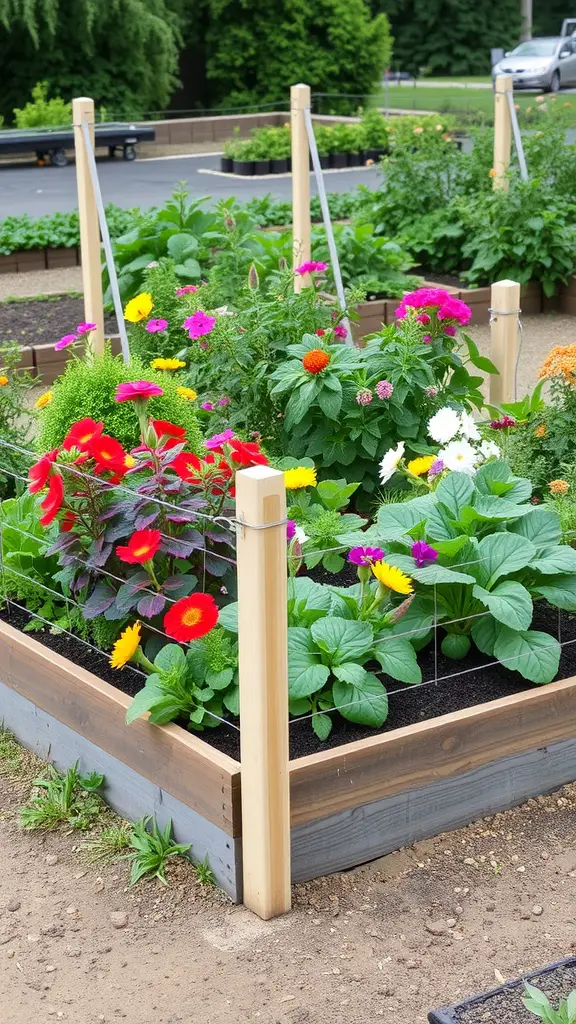
Creating a raised bed with decorative fencing adds charm and functionality to your garden. The image shows a vibrant raised bed filled with colorful flowers, showcasing how a bit of structure can enhance your gardening experience.
The wooden posts and wire fencing not only define the space but also provide support for climbing plants. This setup is perfect for keeping your plants organized and protected from wandering pets or curious critters.
Incorporating flowers like zinnias and marigolds adds a splash of color, making the garden visually appealing. You can mix vegetables and flowers to create a lively and productive space. This layout encourages biodiversity and can attract beneficial insects.
When planning your raised bed, think about the types of plants you want to grow and how they will interact. The decorative fencing can be customized to fit your style, whether you prefer a rustic look or something more modern. Overall, this design not only serves a purpose but also enhances the beauty of your garden.
Raised Bed with Native Plants
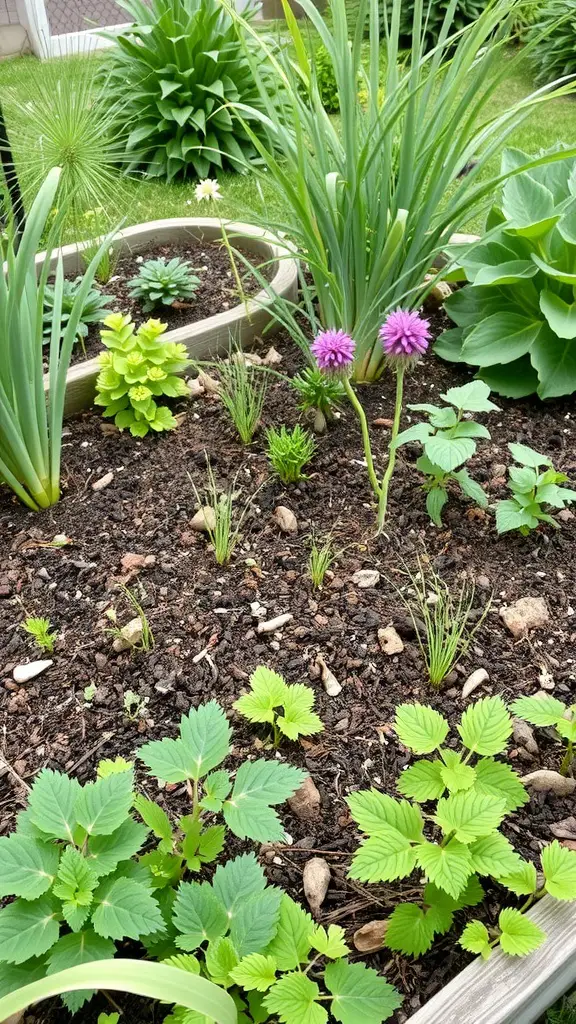
Creating a raised bed with native plants is a fantastic way to enhance your garden while supporting local wildlife. Native plants are adapted to your local climate and soil, making them easier to care for and more resilient.
In the image, you can see a vibrant mix of native plants thriving in a raised bed. The variety of textures and colors adds visual interest. The tall green shoots and colorful flowers create a lively atmosphere, inviting pollinators like bees and butterflies.
Using native plants not only beautifies your space but also helps maintain the local ecosystem. They require less water and fertilizer compared to non-native species, making them a sustainable choice for gardeners.
Consider incorporating plants that bloom at different times throughout the season. This way, your raised bed remains attractive and supports wildlife year-round. Plus, it’s a great way to enjoy the changing seasons in your garden!
Raised Bed in a Community Garden
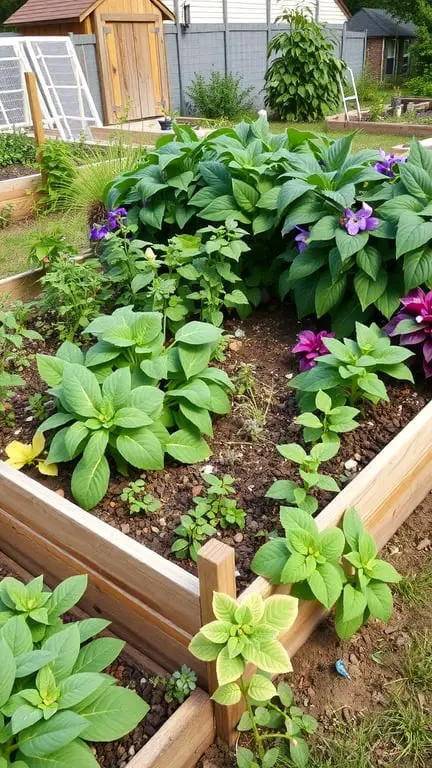
Community gardens are a fantastic way to bring people together, and raised beds play a key role in that. In the image, you can see a vibrant community garden filled with raised beds. These beds are not just practical; they create a welcoming space for neighbors to connect.
The raised beds are neatly arranged, making it easy for gardeners to tend to their plants. You can spot a variety of greenery, from leafy vegetables to herbs, showcasing the diversity of what can be grown. This layout encourages collaboration and sharing among community members.
People are actively engaged in gardening activities, whether planting, weeding, or simply enjoying the sunshine. This interaction fosters a sense of community and promotes healthy living. Raised beds in community gardens also help with soil drainage and can be easier for people with mobility issues to access.
Overall, raised beds in a community garden not only enhance the gardening experience but also strengthen community bonds. They are a perfect example of how gardening can bring joy and connection to our lives.
